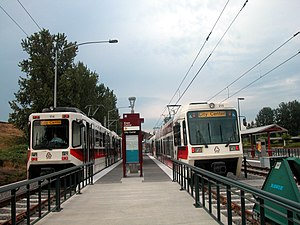Expo Center station
| MAX Light Rail station | |||||||||||
 | |||||||||||
| General information | |||||||||||
| Location | 2060 North Marine Drive at Portland Expo Center Portland, Oregon USA | ||||||||||
| Coordinates | 45°36′20″N 122°41′08″W / 45.60556°N 122.68556°W | ||||||||||
| Owned by | TriMet | ||||||||||
| Platforms | 1 side and 1 island platform | ||||||||||
| Tracks | 3 | ||||||||||
| Construction | |||||||||||
| Parking | 300 total spaces | ||||||||||
| Bicycle facilities | Lockers | ||||||||||
| Accessible | Yes | ||||||||||
| History | |||||||||||
| Opened | May 1, 2004 | ||||||||||
| Services | |||||||||||
| |||||||||||
| |||||||||||
Expo Center is a light rail station on the MAX Yellow Line in Portland, Oregon, United States. It is the last stop northbound on the Interstate MAX extension.
This station is a large park-and-ride station located on the grounds of the Portland Expo Center. It is set up as a modified side platform station, with the two platforms serving three tracks. The extra track allows the storage of an overflow train for events at the Expo Center. The 300 park-and-ride spaces are free for commuters arriving before 10 am on weekdays for a maximum 24 hours. At all other times, drivers must pay the Expo Center's usual $7–8 parking fee.
Although tracks and electrification end directly inside the station, it is designed to allow a future northbound extension (to Vancouver, Washington) to be easily constructed.
Both the landscaping and the artwork at the station are themed in a Japanese style. This recalls the temporary Civilian Assembly Center that existed here during the early days of World War II, which processed Japanese-Americans upon the enforcement of Executive Order 9066.[1]
Bus line connections
[edit]This station is at the Expo Center served by the following bus line:
- 11 - Rivergate/Marine Dr
Unique station features
[edit]The station includes several unique decorative features relating to the internment camp theme:[2]
- Timber Gateway: Traditional Japanese Gates, with steel internment tags strung among them
- Bronze Trunks: Provide additional seating.
- Bamboo Glass Blocks
- Plaque: A plaque showing the prohibited area as defined in Exclusion Order #26 for those of Japanese ancestry, both alien and non-alien.
-
Timber gateway and a waiting train. Facsimiles of historical newspaper headlines are at the base of the wooden poles.
-
Timber gateway strung with replica steel internment tags.
-
Example of etchings on timbers.
-
Close-up of bamboo glass blocks on systems building.
-
Bronze trunk seating. Inset shows tiled box from the other trunk.
-
A plaque of the exclusion order #26, showing the prohibited area.
References
[edit]- ^ Chuang, Angie (September 11, 2003). "Embracing the future, remembering the past: TriMet dedicates the Expo Center MAX Station, once a temporary WW II internment camp". The Oregonian.
- ^ "Art on Interstate MAX Yellow Line". TriMet. Retrieved 2009-11-27.
External links
[edit]- Station information from TriMet
- MAX Light Rail Stations – more general TriMet page
- Park and Ride Locations – general TriMet page







